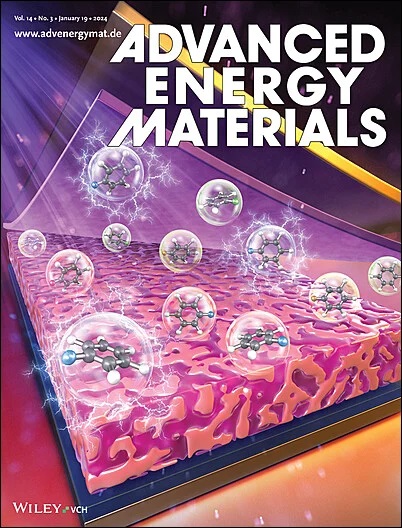Synchronous Hetero-Interface and Vacancy Engineering for Construction of Pitaya-Like CoSe1-x/C@NC@ZnSe Nanosphere Toward Ultrastable Sodium-Ion Half/Full Batteries
IF 24.4
1区 材料科学
Q1 CHEMISTRY, PHYSICAL
引用次数: 0
Abstract
Transition metal selenides have attracted extensive attention as promising anode materials for sodium-ion batteries (SIBs) due to their fascinating physical chemistry characteristics. However, its cycling performance especially at high currents, is still unsatisfactory owing to the intrinsic limited conductivity. Herein, N-doped carbon shell coated and ZnSe bonded Se-vacancy enriched CoSe1-x (CoSe1-x/C@NC@ZnSe, CZSCV) nanospheres with abundant hetero-interfaces are designed through an in situ Se transfer strategy. Owing to the ingenious structure, as an anode material in SIBs, CZSCV demonstrates superior cycling stability (363.5 mAh g−1 at 10 A g−1 after 1000 cycles) and high-rate sodium storage capability (193.9 mAh g−1 at 20 A g−1 after 5000 cycles). Meanwhile, in the CZSCV//Na3V2(PO4)3@C full cell, it also delivers a stable capacity of 201.4 mAh g−1 at 1.0 A g−1 and provides a high energy density of 397.4 Wh kg−1 with a power density of 231.6 W kg−1. Based on the kinetics analysis and the density functional theory calculation, the hetero-interfaces and enriched Se-vacancies can synergistically accelerate the Na+/electron transfer, owing to the charge redistribution, the decreased diffusion barrier of Na+ and increased pseudo-capacitive capacity contribution. As a result, excellent high-rate anode material can be achieved for the SIBs.

构建火龙果样CoSe1-x/C@NC@ZnSe纳米球的同步异界面和空位工程用于超稳定钠离子半/满电池
过渡金属硒化物作为钠离子电池极具发展前景的负极材料,因其独特的物理化学特性而受到广泛关注。然而,由于固有的导电性限制,其循环性能,特别是在大电流下,仍然令人不满意。本文通过原位硒转移策略,设计了n掺杂碳壳包覆和ZnSe键合富集硒空位的CoSe1-x纳米球(CoSe1-x/C@NC@ZnSe, CZSCV)。由于其独特的结构,作为sib的阳极材料,CZSCV具有优异的循环稳定性(在1000次循环后,在10 A g−1条件下可达到363.5 mAh g−1)和高速率的钠存储能力(在5000次循环后,在20 A g−1条件下可达到193.9 mAh g−1)。同时,在CZSCV//Na3V2(PO4)3@C全电池中,它在1.0 a g−1下也提供了201.4 mAh g−1的稳定容量,并提供了397.4 Wh kg−1的高能量密度,功率密度为231.6 W kg−1。基于动力学分析和密度泛函理论计算,异质界面和富集的se空位可以通过电荷重分布、Na+扩散势垒降低和伪电容容量贡献增加来协同加速Na+/电子的转移。为sib提供了优良的高速率阳极材料。
本文章由计算机程序翻译,如有差异,请以英文原文为准。
求助全文
约1分钟内获得全文
求助全文
来源期刊

Advanced Energy Materials
CHEMISTRY, PHYSICAL-ENERGY & FUELS
CiteScore
41.90
自引率
4.00%
发文量
889
审稿时长
1.4 months
期刊介绍:
Established in 2011, Advanced Energy Materials is an international, interdisciplinary, English-language journal that focuses on materials used in energy harvesting, conversion, and storage. It is regarded as a top-quality journal alongside Advanced Materials, Advanced Functional Materials, and Small.
With a 2022 Impact Factor of 27.8, Advanced Energy Materials is considered a prime source for the best energy-related research. The journal covers a wide range of topics in energy-related research, including organic and inorganic photovoltaics, batteries and supercapacitors, fuel cells, hydrogen generation and storage, thermoelectrics, water splitting and photocatalysis, solar fuels and thermosolar power, magnetocalorics, and piezoelectronics.
The readership of Advanced Energy Materials includes materials scientists, chemists, physicists, and engineers in both academia and industry. The journal is indexed in various databases and collections, such as Advanced Technologies & Aerospace Database, FIZ Karlsruhe, INSPEC (IET), Science Citation Index Expanded, Technology Collection, and Web of Science, among others.
 求助内容:
求助内容: 应助结果提醒方式:
应助结果提醒方式:


